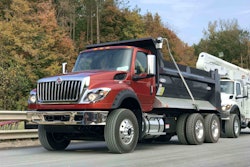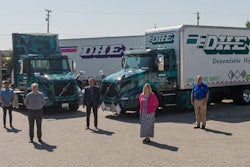
When you cut to the basic principles of heavy-duty trucks it comes down to return on investment: maximum mpg, meeting emissions requirements and the truck running at optimum conditions and mechanically sound for as long as possible. For the highly complex engines of today, using modern coolant can help them obtain and maintain optimum mpg and emissions when compared to now out-of-date technology.
 Colin Dilley, Ph.D., is the Vice President Technology for Prestone Products Corporation.
Colin Dilley, Ph.D., is the Vice President Technology for Prestone Products Corporation.There’s an old joke about two people driving in a car when the passenger glances at the dashboard and notices that the “check engine” light is on. After the passenger points it out, the driver replies, “Yeah, I saw that. I guess that means it’s working.”
The joke calls out the average “non-professional” driver’s tendency to ignore warning signs and delay preventive maintenance. In other words, by the time that light begins flashing, it may be too late to prevent a breakdown. While HD vehicles and HD maintenance are more managed than the everyday car, there is still more that can be done, especially in regards to the cooling system. When considering a heavy-duty truck’s cooling system, recent estimates by the American Trucking Association’s Technology & Maintenance Council, along with FleetNet America, suggest that upwards of 40% of all heavy-duty engine problems can emanate from a faulty cooling system.
Unfortunately, keeping a heavy-duty truck’s cooling system in tip-top condition got more complex around 10 to 15 years ago when diesel-engine manufacturers began changing the way they engineered and built their products. The most significant changes came with the mission to increase miles per gallon and decrease emissions through the creation and use of new lightweight engines and components.
Simply put, the use of lighter alloys equals better fuel efficiency. Aluminum alloys and reinforced plastics have replaced cast iron, copper and brass. By extension, engine-manufacturing methods have had to change, most notably with the introduction of new solders, fluxes and elastomers. The chemistry and properties of these new materials are vastly different than 25, 10 or even 5 years ago, causing issues with how coolant reacts with the new engine components. Next-generation electronics and computer monitoring makes it even more complicated.
While cooling-system capacities are now lower in the search for reduced weight and higher mpg, they are being asked to operate at higher temperatures. All in all, the tolerances for operational optimization have been significantly reduced, making the ability to remove heat from the smaller more powerful engines even more critical.
Fuel economy increases and lighter aluminum adds benefits compared to materials used in legacy heavy-duty diesel engines, but also has much different issues. The new systems, not protected correctly, are more prone to suffering from different forms of corrosion, heat stress, damage and electrolysis. The controlled atmosphere brazing (CAB) manufacturing method that is now commonly used to join aluminum parts can leave small amounts of flux behind, which can react adversely with the inhibitors in traditional nitrite-based antifreeze/coolants (AF/C).
This reaction can change the coolant’s acidity to a level that can result in corrosion, plugged filters, coated heat exchangers and the buildup of scale on cylinder liners. This can also cause heat to be retained, resulting in the creation of hot spots that can cause fuel pre-ignition. All of these adverse reactions limit the ability of the newer smaller cooling systems to cool the engine to its optimum temperature, resulting in lower oil viscosity and increased engine wear, reduced mpg, increased emissions and significant downtime.
So, put together, this means that selecting the proper AF/C is more important than ever if next-generation heavy-duty Class 7 and 8 diesel engines are to operate at their optimum and reliable best.
The solution to this conundrum appears to be a new formulation of Nitrite-Free Organic Acid Technology (NF OAT) AF/C with an inhibitor package designed for these new engines. These inhibitor additives have been designed to protect all materials and eliminate the negative effects of the CAB manufacturing process. The inhibitors enable the NF OAT AF/C to instantly bond to the cooling-system components, significantly lowering or eliminating all surface-area corrosion and erosion when compared to nitrite-heavy AF/C fluids. This new inhibitor formulation also possesses the ability to seek out and protect hot spots from cavitation corrosion, which are notorious points for engine damage that can result in leaks and costly breakdowns.
Other benefits of NF OAT AF/C with the new inhibitor additives are:
- Extended service life of up to 1 million miles or 20,000 hours of operation
- Improved compatibility with the elastomers in cooling-system seals and gaskets
- Improved AF/C formula stability for optimized overall performance
- Cooler operation for preservation of oil viscosity, which improves engine life and performance
- Improved coolant stability for older AF/C that is topped off with the new formulation
A heavy-duty truck breakdown is no joke, with significant costs in downtime, repair and part replacement sure to be incurred. That’s why smart professional fleet managers and independent operators must be sure that when their rolling stock hits the streets, it is in the best working condition possible. With the advances in today’s diesel-engine technologies, that likely means a cooling system operating with an NF OAT AF/C – one that offers inhibitor additives that can deal with the aftereffects of the CAB process and the demands of low-weight, but more sensitive, aluminum-component construction.
Colin Dilley, Ph.D., is the Vice President Technology for Prestone Products Corporation. Prestone manufactures and markets Prestone antifreeze/coolant and related products.











